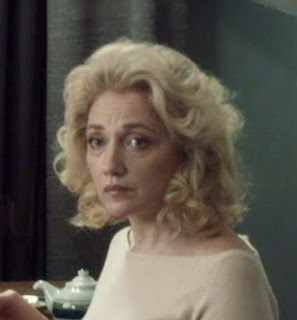Featured at the Museum of Fine Arts Arab Film Weekend, June 8–11
-->
It’s the present
day, and Nada Suleyman (Golshifteh Farahani)
returns to her childhood home in Aley, Lebanon, and occupies the family’s once
elegant villa, long since abandoned as a result of Lebanon’s civil war,
1975–1990. Nada, whose family resettled in Paris, has come back for her Aunt
Nour’s imminent death, but upon seeing the ruined and looted house memories
return, both of an idyllic childhood and a traumatic departure that involved
the disappearance of her beloved grandfather, patriarch of the family. The
movie is about Nada’s quest to find out what happened to her grandfather,
particularly as she believes the majority Druze villagers murdered him. Her
family belongs to the Catholic community, and she rebels at how members of her
extended family still living in Aley pretend nothing ever happened to them during
and after the war. But Aunt Nour, just before her death, vehemently decries how
the two sides feel only hatred that results in blood.
Throughout
the movie, Nada has flashbacks to childhood—her adoring grandfather but also
disturbing images of him involved in ethnic violence with other men outside the
garden gate. In the end, a culminating flashback liberates Nada from her long
torment about her grandfather and her own traumatic wartime experience.
Besides
being a quest movie to solve a painful family mystery, Go Home shows the tension between diverse religious communities
sharing the same village. Barriers are a given, history simmers just beneath
the surface, even though both sides keep up appearances. Basic hostility is a
permanent state, centuries old, but tolerance is practiced on both
sides for the sake of peaceful coexistence. Within their own communities, they denigrate
each other. Even the village priest exhorts Nada not to sell the house: “We
have to keep the land and not leave it to others.” The others are right there in
the background paying the expected condolences for Nour’s death.
In
Aley, the Catholics appear well off and the Druze, a Muslim sect, less
affluent. Nada’s extended family dress elegantly, whereas “the neighbors” wear
work clothes. We see only Druze men and only Catholic women, except for the
priest, possibly suggesting another layer of differences in the two cultures. In
the film, French is spoken by the upper class (Lebanon was formerly a French
colony and until the civil war had a Catholic majority); most of the
characters—Catholic and Druze—speak Arabic, French, and English. Nada, though, has
forgotten, or blocked, her Arabic.
Music
plays a strong role in the movie and is one of the film’s highlights, the work
of Beatrice
Wick and Bachar Mar Khalife.
It clangs and echoes cacophonously, as if in a dungeon or prison, but at the
same time, its strange, discordant sounds open up evocatively to the vast mountain
landscape, often shot in dusky shadows, where other haunting sounds slip in and out—strains
of Arab vocals—like fleeting memories, ancient history, the human experience.
From
a Western audience’s viewpoint, the sister-brother relationship has incestuous implications.
Nada hangs her underwear in the repossessed house as if to display its sexy
allure to her brother Sam (Maximilien Seweryn), who arrives after the funeral to sell
the house for their absent father. The siblings, now in their thirties, banter
coarsely in their childhood way, but when they romp in bed one night, we feel
uneasy about Nada’s attraction to Sam and his own disturbance at their intimacy.
When the movie ends anticlimactically and ambiguously, it’s within the realm of
possibilities that brother and sister will remain in the Aley family home
together. We never learn what Nada has done with her life. She appears
unemployed and without a life purpose, other than restoring the house and
keeping herself occupied inside it. Her brother, on the other hand, works for
their father and mixes easily with the local villagers. For all their years of
living in the enlightened West, their roles come across as traditional—big
brother protector and domestic sister.
The
cinematography makes up for some of the film’s weaknesses, such as its banal
ending and the overused flashback device that incrementally reveals
the truth. Visually, the interior night shots amplified by the eerily captivating
music create atmosphere, and the misty, foggy exterior scenes exude power.
Aley lies fifteen kilometers north of Beirut and is known as “the city of fog.”
Go Home succeeds in showing us, without telling us, a
social-cultural divide in an historical area of the factional and warring
Middle East.


